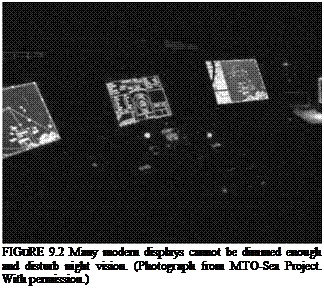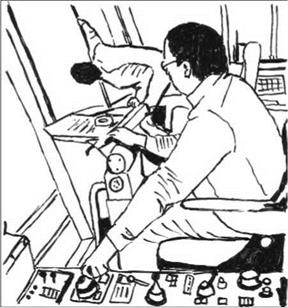A satisfactory level of lighting should be available to enable the bridge personnel to complete such tasks as maintenance, chart, and office work satisfactorily, both at sea and in port, daytime and night-time (IMO, 2000). The following bulleted list and table contain an overview of important lighting points (IMO, 2000): [19]


![]() Essential information will need to be identified as such. Cross-system consistency will be required.
Essential information will need to be identified as such. Cross-system consistency will be required.
|
SCC layout |
Information |
The layout needs to |
SCC design needs to |
|
and design |
provision to each |
allow supervision |
proceed in an |
|
operating position |
and teamwork. |
integrated manner. |
|
|
will need to be |
Proving that this aim |
||
|
fully considered. |
has been met will require user-centred design through the life cycle. |
Source: ATOMOS.
|
|||||||||||||||||||||||||||||
|
FIGURE 9.1 Manoeuvring a ship close to an oil rig cannot be done by one person. (Drawing by E. Jacobson after a photo. With permission.) |
• The lighting system should enable the bridge personnel to adjust the lighting in brightness and direction as required in different areas of the bridge and by the needs of individual devices. Table 9.3 lists the recommended general illumination levels and colours.
• A light-dimming capability should be provided.
• Utmost care should be taken to avoid glare and stray image reflections in the bridge environment.
• Lighting sources should be designed and located to avoid creating glare from working and display surfaces.
• Reflection in windows of devices, instruments, consoles, and other reflective enclosures should be avoided.
• Devices should be designed and fitted to minimise glare, reflection, or obscuration by strong light.
Related to lighting is the choice of colours for interior surfaces. For the interior, unsaturated colours should be chosen that give a calm overall impression and minimise reflectance. Bright colours should not be used. Dark or mid-green colours are recommended; alternatively blue or brown may be used. In spite of these guidelines, a very common complaint is about the lack of dimming (Lutzhoft et al., 2007). The bright light destroys night vision, disturbs the keeping of a safe lookout, and distracts attention (see Figure 9.2).
TABLE 9.3
General illumination for the Bridge
 Colour/lllumination
Colour/lllumination
Red or filtered white, continuously variable from 0 to 20 lux White, continuously variable from 0 to at least 300 lux Red or filtered white, continuously variable from 0 to 20 lux Red spotlights, continuously variable from 0 to 20 lux White floodlight, continuously variable from 0 to 1000 lux Filtered white floodlight or spotlights, continuously variable from 0 to 20 lux
 |
Source: IMO (2000).
Not only modern displays cause dimming trouble. Many disturbing points of light are visible on many bridges, and the problem mainly stems from the amount of different manufacturers providing equipment, and the lack of integrated or system design thinking. Homemade dimmers abound, some more innovative than others (see Figure 9.3).




